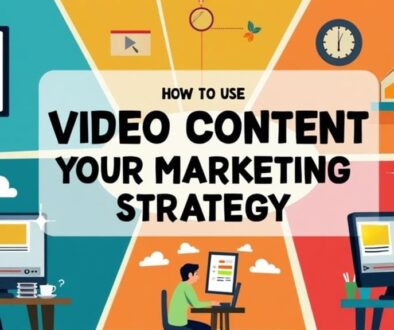How to Develop a B2B Marketing Strategy That Works
To develop a successful B2B marketing strategy, begin by clearly defining your target audience through detailed segmentation and buyer personas. Set SMART marketing goals that align with your broader business objectives to guarantee measurable outcomes. Conduct a thorough competitive analysis to identify differentiators and market positioning. Develop a compelling value proposition that addresses customer pain points, while choosing the right channels for engagement. Craft a strategic content plan that resonates with your audience, and implement lead generation tactics to nurture relationships. Continuous performance measurement and optimization will refine your approach, revealing further insights as you advance.
Key Takeaways
- Understand your target audience by analyzing demographics and behaviors to create effective buyer personas for segmentation.
- Set clear, measurable marketing goals using SMART criteria to guide your strategies and monitor progress.
- Conduct a thorough competitive analysis to differentiate your brand and identify best practices within your industry.
- Develop a compelling value proposition that addresses customer pain points and highlights your competitive advantages.
- Implement a multi-channel engagement strategy that resonates with your audience and utilizes diverse content formats for maximum reach.
Define Your Target Audience

Defining your target audience is a fundamental step in any effective B2B marketing strategy. A granular understanding of your audience empowers organizations to create campaigns that resonate deeply. To achieve this, marketers must develop detailed buyer personas—comprehensive profiles that articulate the characteristics and motivations of potential customers. This process begins with audience segmentation, segmenting the market based on unique traits such as company size, industry, and location.
Demographic analysis is an essential component, allowing businesses to identify key statistics, such as age, income, and education level of decision-makers. However, relying solely on demographics can hinder a marketer's ability to connect authentically. Therefore, psychographic profiling becomes paramount, offering insights into values, interests, and attitudes that drive purchasing decisions.
Staying attuned to industry trends enables marketers to refine their strategic approach while aligning it with evolving market dynamics. This continuous market research not only helps identify customer pain points but also creates opportunities for organizations to offer solutions that genuinely address these challenges.
Behavioral targeting further enhances engagement by analyzing past interactions and predicting future behavior, ensuring content remains relevant.
Ultimately, a precise understanding of your target audience releases the potential for tailored campaigns that speak directly to their needs and aspirations. This meticulous process not only fosters deeper customer relationships but also allows businesses to operate with more freedom in crafting innovative solutions that set them apart in the competitive B2B landscape.
Set Clear Marketing Goals
Setting clear marketing goals is essential for guiding B2B strategies toward measurable outcomes. Establishing these objectives is not merely a task; it is a strategic focus that helps to align efforts, drive performance, and foster accountability. By implementing the SMART criteria—Specific, Measurable, Achievable, Relevant, and Time-bound—you create a framework that enhances clarity and precision in goal setting.
To guarantee KPI alignment, goals must resonate with broader business objectives. When marketing teams have defined timeframes, they can allocate resources more effectively, guaranteeing that efforts are concentrated on high-impact activities. This fosters team collaboration, encouraging members to engage collectively towards shared objectives, markedly enhancing motivational factors.
Furthermore, clear marketing goals serve as performance benchmarks. These benchmarks empower teams to monitor progress continuously, adjusting strategies as necessary to stay on track. Accountability measures allow for transparency in goal achievement, providing a structured pathway for evaluating success against established criteria.
Ultimately, setting clear marketing goals is not merely about numbers; it's about creating a unified vision that inspires freedom and creativity within a structured framework. This balance between ambition and accountability not only enhances overall effectiveness but also cultivates a culture of excellence in B2B marketing strategies.
Conduct Competitive Analysis

In order to navigate the complexities of the B2B landscape effectively, conducting a thorough competitive analysis is imperative. This analysis not only informs your marketing strategy but also shapes your approach to market positioning and brand differentiation.
By understanding your competitors, you can identify opportunities to exploit market gaps while keeping abreast of market trends.
A detailed competitive analysis should include the following components:
- SWOT Analysis: Evaluating competitors' strengths, weaknesses, opportunities, and threats to uncover strategic insights.
- Competitor Strengths: Assessing what each competitor does well to identify the best practices within your industry.
- Pricing Strategies: Analyzing how pricing structures impact customer decisions, helping to refine your own pricing models.
- Product Offerings: Understanding the breadth and depth of competitors' offerings to ascertain potential innovation areas.
- Customer Feedback: Leveraging testimonials and reviews to gauge public perception of competitor strengths and weaknesses.
Develop Value Propositions
A compelling value proposition is fundamental for distinguishing your brand in the competitive B2B landscape, as it clearly articulates the unique benefits your offerings provide to prospective clients.
To develop an effective value proposition, start by identifying key customer pain points and aligning them with your brand messaging. Understanding these pain points enables you to craft solutions that resonate with different buyer personas.
Next, leverage your unique benefits to highlight your competitive advantages. These can include product differentiation, innovative features, or exceptional customer service that addresses specific market needs. Emotionally charged language can be used to connect with potential clients on a deeper level, triggering a response that drives engagement and conversion.
Make sure to take into account stakeholder alignment when conducting this process. It's essential to involve internal teams to guarantee that the proposed value aligns with organizational objectives and resonates across departments. Gathering insights from customer testimonials can validate your claims and further strengthen your positioning.
The clarity of your value proposition plays a significant role in market positioning, allowing prospects to quickly grasp how your solution stands out from competitors.
Ultimately, an effective value proposition not only communicates what you offer but encapsulates a promise of a solution tailored to alleviate customer pain. By consistently revisiting and refining this aspect of your B2B strategy, you guarantee that your brand remains relevant and compelling in a dynamically evolving marketplace.
Choose the Right Channels

Selecting the appropriate channels for B2B marketing hinges on a thorough understanding of your audience's preferences and behaviors.
By evaluating the effectiveness of various channels, marketers can guarantee their strategies resonate with targets and drive engagement.
This strategic alignment not only enhances outreach but also optimizes resource allocation across chosen platforms.
Understand Your Audience
Understanding your audience is essential for effective B2B marketing, as it greatly influences the channels you choose for outreach.
Employing robust customer personas and audience segmentation helps you tailor your strategies to diverse groups, aligning perfectly with the buyer journey. This targeted approach allows you to address their unique pain points and enhance their decision-making process.
To effectively engage with your audience, consider the following strategies:
- Demographic Analysis: Identify and categorize your audience based on age, industry, and purchasing habits to inform channel selection.
- Behavioral Insights: Analyze interactions with your brand to understand preferences and tailor your messaging.
- Market Trends: Stay updated on industry shifts to guarantee your channels remain relevant and effective.
- Feedback Loops: Regularly gather input from your audience to refine engagement strategies and improve outreach.
- Engagement Strategies: Develop dynamic content that resonates with your audience and encourages interaction across chosen channels.
Evaluate Channel Effectiveness
When evaluating channel effectiveness in B2B marketing, it is essential to analyze both the performance of existing channels and the potential of new ones. This dual assessment enables businesses to enhance channel diversity while maximizing audience engagement.
Start by employing measurement tools and data analytics to gather insights on channel performance. Metrics such as conversion rates and effectiveness metrics provide clarity on which channels yield the highest ROI.
An effective strategy hinges on a thorough ROI assessment spanning current and potential channels. Examine how each channel resonates with your target audience and aligns with your overall marketing objectives.
By evaluating both qualitative and quantitative data, you can identify patterns that may indicate shifts in audience preference or behavior.
Furthermore, leveraging advanced analytics offers the ability to forecast channel success, allowing for informed decisions on resource allocation.
By intertwining channel performance evaluation with strategic planning, organizations can shape marketing efforts that invite sustainable growth and adapt to an ever-evolving market landscape.
Ultimately, choosing the right channels enhances not only effectiveness but also fosters a deeper connection with your audience, paving the way for a thriving B2B ecosystem.
Create a Content Strategy
A robust content strategy serves as the backbone of any successful B2B marketing effort, ensuring that your messaging resonates with your target audience while driving engagement and conversions. To create an effective content strategy, one must adopt a multifaceted approach that aligns with business objectives and addresses the unique needs of various audience personas.
Begin by identifying diverse content types and formats that suit your audience's preferences. Consider incorporating:
- Storytelling techniques to make your content relatable and memorable
- Visual content like infographics and videos to enhance engagement
- User generated content to foster community and authenticity
- SEO strategies to improve visibility and drive organic traffic
- An editorial calendar to maintain consistency and relevance in your messaging
Next, develop a distribution plan to amplify your content's reach across relevant channels. Understand where your target audience congregates and tailor your messaging accordingly.
Additionally, using engagement metrics will allow you to assess effectiveness, enabling data-driven adjustments to your strategy.
Importantly, consider the nuances of both long-form and short-form content formats, as each serves distinct purposes in the B2B landscape. Balancing these elements with a focus on meaningful interactions will create a thorough strategy that not only informs but also inspires action.
Ultimately, your content should cultivate relationships, paving the way for sustainable growth and freedom in your brand narrative.
Implement Lead Generation Tactics

Effective lead generation tactics are essential to convert a curated audience into prospective clients.
By identifying your target audience, utilizing content marketing strategies, and leveraging social media platforms, businesses can create tailored approaches that resonate with potential leads.
This proactive engagement not only enhances visibility but also cultivates meaningful connections that drive business growth.
Identify Target Audience
Identifying the target audience is a crucial first step in implementing effective lead generation tactics within a B2B marketing strategy. A clear understanding of your audience not only enhances your marketing efforts but also drives meaningful engagement with potential clients.
By developing detailed buyer personas and employing audience segmentation, marketers can tailor their strategies to resonate with the right individuals and organizations.
To effectively identify your target audience, consider the following strategies:
- Analyze Existing Customer Data: Utilize insights from current clients to understand demographics and behavior patterns.
- Conduct Market Research: Gather information on industry trends and competitive landscapes that influence your target audience.
- Create Detailed Buyer Personas: Develop representations of ideal customers, incorporating motivations, pain points, and purchasing behavior.
- Segment Your Audience: Divide your audience into distinct groups based on criteria such as industry, company size, or decision-making authority.
- Engage with Prospects: Directly communicate with potential clients to refine your understanding of their needs and preferences.
Utilize Content Marketing
Leveraging content marketing serves as a powerful mechanism for driving lead generation within a B2B marketing strategy. By utilizing diverse content types such as blog formats, case studies, and user-generated content, businesses can enhance audience engagement and nurture potential leads. This multifaceted approach not only informs but also captivates target audiences, fostering a sense of connection and trust.
Incorporating effective storytelling techniques amplifies the emotional resonance of the content, thereby elevating the brand's presence as a thought leader in its industry. Enhanced audience interaction encourages deeper insights into customer needs and motivations.
Concurrently, implementing robust SEO strategies guarantees that this content is visible and easily accessible across various platforms.
Moreover, leveraging visual content enhances understanding and retention, making complex ideas more digestible. A nuanced content distribution strategy further maximizes reach and effectiveness, allowing businesses to share their insights where their audience is most active.
Leverage Social Media
Social media platforms have transformed into dynamic ecosystems for B2B lead generation, offering businesses a direct line to engage with their target audience. To effectively leverage these platforms, organizations must prioritize strategic approaches that encompass various aspects of social media utilization.
- Platform selection: Choose the right platforms based on audience insights and industry trends.
- Social listening: Monitor brand mentions and industry conversations to align marketing efforts with audience needs.
- Influencer partnerships: Collaborate with industry influencers to expand reach and credibility within niche markets.
- Content sharing: Create valuable, shareable content that resonates with your audience, fortifying your brand voice.
- Analytics tools: Utilize analytics tools for trend analysis to assess which strategies yield ideal audience engagement.
Through purposeful community building and tailored paid advertising campaigns, businesses can enhance their visibility and foster stronger connections.
By capitalizing on audience engagement and understanding their preferences, companies can cultivate a compelling brand narrative on social media that drives lead generation and nurtures long-term relationships.
Ultimately, a well-executed social media strategy can serve as a cornerstone in your B2B marketing efforts, revealing untapped potential for growth and freedom in a competitive landscape.
Measure and Optimize Performance
In the domain of B2B marketing, measuring and optimizing performance is essential for driving effective strategies and ensuring a return on investment. The foundation of this process lies in establishing clear performance metrics that allow marketers to gauge the success of their initiatives.
By leveraging marketing analytics, businesses can dissect various aspects of their campaigns, uncovering patterns and insights that inform decisions.
One powerful method for optimization is A/B testing, which can greatly enhance conversion rates by comparing two variants of a single campaign element. This technique not only identifies the most effective approaches but also contributes to a culture of continuous improvement.
Incorporating robust data analysis into your strategies creates informed feedback loops, enabling marketers to iteratively refine their tactics based on real-world performance.
Moreover, a detailed ROI assessment must accompany every marketing effort. This means quantifying the financial returns of various campaigns, ensuring that resources are allocated wisely to the most effective channels.
Techniques such as funnel analysis also provide insights into where potential customers drop off, further informing optimization techniques that can boost overall performance.
Ultimately, the goal is to create a dynamic system where every campaign is an opportunity to learn and adapt. By consistently measuring and optimizing performance, B2B marketers not only enhance their strategies but also empower their teams to pursue innovative, freedom-driven solutions that resonate with their target audiences.
Frequently Asked Questions
How Do I Prioritize Marketing Tactics Effectively?
Prioritizing marketing tactics effectively necessitates a strategic approach to tactic selection based on performance metrics.
Begin by analyzing historical data to identify the tactics that yield the highest returns. Consider the alignment of each tactic with your overall business objectives, and assess their potential to engage target audiences.
What Budget Should I Allocate for B2B Marketing?
A recent study reveals that companies allocating 6-10% of their revenue to marketing typically enjoy a higher ROI.
Determining your marketing budget necessitates a thorough cost analysis, ensuring effective resource allocation while maintaining budget flexibility.
Prioritize rigorous expense tracking and financial forecasting to optimize investment strategies.
Focus on ROI measurement to guide future budget adjustments, facilitating informed decisions that align with business growth and market demands, ultimately driving successful marketing efforts.
How Often Should I Review My Marketing Strategy?
To guarantee the effectiveness of your marketing efforts, strategy adjustments should be made regularly.
Conducting quarterly reviews allows for a systematic evaluation of performance metrics and market trends. This frequency strikes a balance between being reactive to immediate changes and maintaining a long-term vision.
What Role Does Customer Feedback Play in Strategy Development?
Customer feedback is essential in shaping effective marketing strategies. Leveraging customer insights through feedback loops, such as client surveys, allows businesses to identify market trends and understand client needs more deeply.
This, in turn, facilitates data-driven decisions, ensuring that strategies remain relevant and competitive. Conducting competitive analysis further refines this approach, enabling firms to adapt and innovate based on real-world observations.
Ultimately, this drives customer satisfaction and business growth.
How Can I Ensure My Team Is Aligned With the Strategy?
Ensuring team alignment with a strategy necessitates effective team communication and engagement.
To foster this environment, consider conducting strategic workshops that encourage collaborative idea-sharing and feedback. These sessions should emphasize the importance of unified goals, allowing team members to discuss their roles in executing the strategy.
Conclusion
A well-crafted B2B marketing strategy serves as a navigational compass, guiding organizations through the intricate landscape of diverse audiences and competitive forces. By meticulously defining target segments and establishing clear objectives, businesses can illuminate their unique value propositions. Employing the appropriate channels and content strategies effectively cultivates leads, while continuous performance measurement guarantees adaptability. Ultimately, this cohesive approach not only enhances visibility but also fosters lasting partnerships, transforming initial connections into robust, mutually beneficial relationships.




